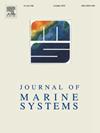越南东北部红河羽流区域的拉格朗日色散,来自漂流观测和模拟
IF 2.5
3区 地球科学
Q2 GEOSCIENCES, MULTIDISCIPLINARY
引用次数: 0
摘要
河流羽流和邻近水域内物质的运输和空间分布受到羽流形态和包围羽流区域的锋面的强烈影响。因此,确定地幔柱锋面的位置和评估锋面混合活动对于了解生物地球化学示踪剂的空间分布以及源(河口)和近海区域之间的连通性尤为重要。通过2022年夏季在东京湾进行的漂流实验和实际数值模拟,获得了红河(RR)羽流区域水平弥散的统计特性。采用拉格朗日视角,利用有限尺寸李雅普诺夫指数(FSLE)从地表流场提取拉格朗日相干结构(LCS),提出了一种表征RR羽流形态的方法。吸引FSLE场的极大值(FSLE脊线)使我们能够识别气流中的电流辐合和切变区域,这对于表征与羽流相关的动力学和绘制划定它们的锋面是必不可少的。很明显,RR羽流体是由RR三角洲体系的单个河流羽流形成的。FSLE脊线可以识别单个羽流的近海扩张,并揭示了各种形式,半圆形或钩状细丝,表征了羽流的形状。在羽流区域内发现弹道型弥散,主要方向垂直于海岸流动方向,表现出各向异性剪切弥散。观测尺度为0.3 ~ 3 km(亚中尺度范围),最大值为10-13天−1,这是根据实际漂流者的尺度相关相对分散分析得出的。在模式模拟中,在2 km以下的范围内,相对弥散与尺度无关,表明网格分辨率对模式的横向混合表示有显著影响。本文章由计算机程序翻译,如有差异,请以英文原文为准。
Lagrangian dispersion in the Red River plume region, Northeast Vietnam, from drifter observations and modeling
The transport and spatial distribution of materials within river plumes and neighboring waters are strongly influenced by the plume morphology and fronts bounding the plume area. Thus, identifying locations of plume fronts and assessing frontal mixing activity is particularly important for understanding the spatial distribution of biogeochemical tracers and the connectivity between source (river mouth) and offshore regions. Statistical properties of horizontal dispersion in the Red River (RR) plume region were obtained from drifter experiments, conducted in the Gulf of Tonkin during summer 2022, and also from realistic numerical modeling. Adopting a Lagrangian perspective, a method is proposed to characterize the RR plume morphology based on the extraction of Lagrangian Coherent Structures (LCS) from the surface flow field using Finite-Size Lyapunov Exponents (FSLE). Maxima of the attracting FSLE field (FSLE ridge lines) enabled us to identify zones of current convergence and shear in the flow, which are essential for characterizing the dynamics associated with plumes and mapping the fronts delimiting them. It became clear that the body of the RR plume is formed by the individual river plumes of the RR deltaic system. FSLE ridge lines allowed identification of the offshore expansion of individual plumes and revealed a variety of forms, semi-circular or hook-like filaments, characterizing the plume shape. The ballistic regime of dispersion was found inside the plume region, with the dominant direction perpendicular to the coastal flow direction revealing anisotropic shear dispersion. It was observed at scales of 0.3 to 3 km (submesoscale range), with a maximum value of 10–13 day−1, as derived from the analysis of the scale dependent relative dispersion of real drifters. In model simulations, the relative dispersion appeared scale independent in the range below 2 km, indicating a significant effect of grid resolution on the model's representation of lateral mixing.
求助全文
通过发布文献求助,成功后即可免费获取论文全文。
去求助
来源期刊

Journal of Marine Systems
地学-地球科学综合
CiteScore
6.20
自引率
3.60%
发文量
81
审稿时长
6 months
期刊介绍:
The Journal of Marine Systems provides a medium for interdisciplinary exchange between physical, chemical and biological oceanographers and marine geologists. The journal welcomes original research papers and review articles. Preference will be given to interdisciplinary approaches to marine systems.
 求助内容:
求助内容: 应助结果提醒方式:
应助结果提醒方式:


